What is Cybersecurity?
Cybersecurity is the practice of protecting computers, servers, networks, devices, and sensitive data from malicious digital attacks and unauthorized access. It encompasses a comprehensive set of security measures, tools, and best practices to safeguard individual users and organizations from evolving cyber threats.
Modern cybersecurity focuses on five key areas:
- Network security to protect communication pathways
- Application security to keep software and devices safe
- Information security to safeguard both data in storage and in transit
- Operational security to handle user permissions and data access
- Disaster recovery and business continuity to respond to cybersecurity incidents
Common cybersecurity threats include sophisticated malware attacks, social engineering schemes like phishing, ransomware that encrypts valuable data, and targeted data breaches. Organizations must implement robust security measures to protect sensitive information and comply with data protection regulations like GDPR, HIPAA, and CCPA.
The True Cost of Cyberattacks: Business Impact and Risks
According to Forrester's Predictions 2025 report, cybercrime damages are projected to reach $12 trillion globally in 2025. Organizations face mounting challenges as security, risk, and privacy leaders work to balance technical risk management with regulatory compliance in an increasingly digital business landscape.
Understanding the Business-Wide Impact of Cyber Threats
Cyberattacks have evolved beyond traditional IT concerns into critical business risks that demand comprehensive organizational response strategies. Here's how cyber incidents impact modern businesses across multiple dimensions:
Devastating Financial Impact
Modern cyberattacks inflict severe financial damage, with the average data breach now costing organizations $4.88 million. This includes immediate costs like ransomware payments and long-term expenses such as:
- System recovery and infrastructure upgrades
- Regulatory penalties and compliance modifications
- Legal fees and potential settlements
- Lost revenue during operational downtime
- Cybersecurity improvement investments
Long-Term Reputational Consequences
The reputational fallout from cyberattacks often outlasts the immediate technical impact:
- Erosion of customer trust and brand loyalty
- Decreased market value and investor confidence
- Loss of competitive advantage
- Damaged relationships with business partners
- Negative media coverage and public perception
Anatomy of a Supply Chain Attack
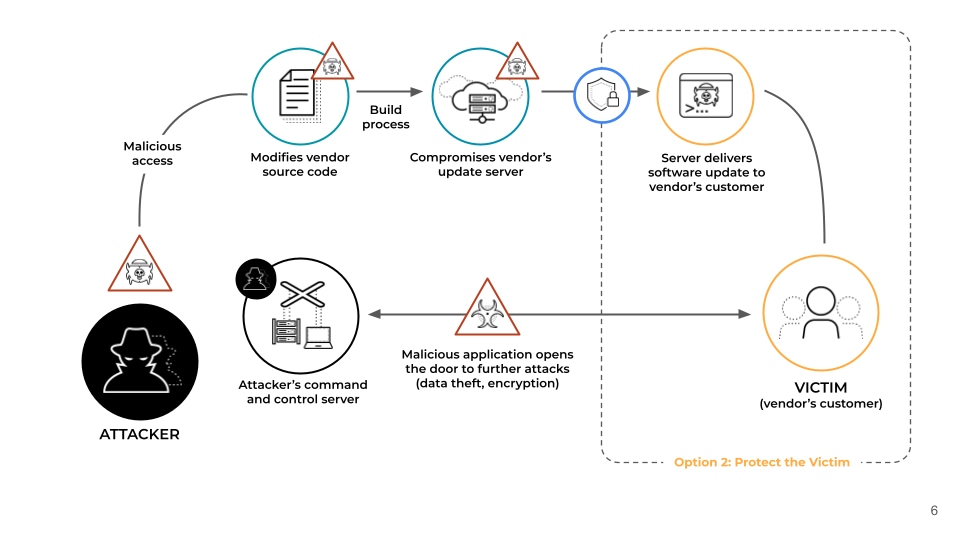
Business Operations and Continuity
Cyberattacks severely disrupt daily operations:
- Critical system downtime affecting core business functions
- Supply chain interruptions impacting partner networks
- Reduced workforce productivity
- Delayed product launches and service delivery
- Resource diversion to incident response
Regulatory Compliance and Legal Exposure
Modern cyber incidents trigger complex regulatory obligations:
- Mandatory breach reporting to authorities
- Customer notification requirements
- Regulatory investigations and audits
- Potential class-action lawsuits
- Increased oversight and compliance costs
Data Security and Privacy Impact
Data compromises have far-reaching consequences:
- Loss of intellectual property and trade secrets
- Exposure of sensitive customer information
- Increased risk of identity theft and fraud
- Compliance violations across multiple jurisdictions
- Long-term data protection challenges
Small Business Vulnerability Crisis
Small and medium-sized businesses face unique challenges:
- Limited cybersecurity resources and expertise
- Higher vulnerability to sophisticated attacks
- Devastating impact: 60% of small businesses close within six months of a significant cyber incident
- Difficulty accessing cyber insurance
- Challenges meeting security requirements of more significant partners
Workforce and Cultural Impact
Cyberattacks affect organizations at the human level:
- Potential job losses due to financial impact
- Decreased employee morale and productivity
- Increased workplace stress and burnout
- Changes to work processes and security policies
- Need for ongoing security awareness training
Industry-Specific Considerations
Different sectors face unique cybersecurity challenges:
- Healthcare: Patient data protection and medical device security
- Financial Services: Payment system and transaction security
- Retail: Point-of-sale and e-commerce platform protection
- Manufacturing: Industrial control system security
- Technology: Intellectual property and source code protection
Why is Cybersecurity Important?
Comprehensive cybersecurity measures are essential because data breaches can cause severe financial and reputational damage. The rise of digital collaboration and remote work further underscores the need for strong security systems, enabling safe and efficient operations in both personal and professional settings.
Sensitive and Personal Data
- Safeguards Personal Information: Cybersecurity measures, such as encryption, access controls, and advanced protocols, protect private data such as financial details and social security numbers.
- Ensures Security for Online Services: With the proliferation of online banking, e-commerce, and social platforms, protecting user data is more critical than ever.
- Prevents Risks: A cybersecurity failure can lead to identity theft, financial losses, and privacy breaches. Robust strategies mitigate these risks.
- Adapts to Technological Advances: As digital threats evolve, so too must cybersecurity tactics, ensuring individuals can navigate the online world safely.
Businesses
- Protects Intellectual Property: Cybersecurity safeguards proprietary information, customer data, and intellectual assets from cyber threats.
- Maintains Trust: Secure systems foster consumer confidence and prevent reputational damage.
- Ensures Continuity: Strong security measures protect against financial losses and operational disruptions caused by cyberattacks.
Governance
- Secures Critical Infrastructure: Cybersecurity protects essential services like energy, transportation, and communication networks.
- Safeguards National Security: It ensures secure government operations and protects sensitive data from potential threats.
- Upholds Electoral Integrity: Resilient cybersecurity measures prevent foreign interference in elections, ensuring democratic processes remain secure.
Types of Cybersecurity
Cybersecurity can be categorized into several specialized areas or domains, each crucial in safeguarding different aspects of digital security. Following are some of the most common types.
Network Security
Network security is vital in protecting sensitive data, ensuring uninterrupted operations, and enabling secure connectivity between users and systems. Key functions include monitoring traffic for threats, implementing VPNs for secure remote access, and adapting protections for cloud environments. A strong strategy involves regular audits, penetration testing, and continuous updates to address vulnerabilities and keep pace with evolving cyber threats.
Application Security
Application security is crucial for protecting sensitive information, stopping cyber threats, and keeping users' trust in applications. Key practices involve writing secure code, thorough testing, and constant monitoring to find and fix weaknesses. Securing third-party and cloud applications while being proactive against ongoing risks is vital to deal with new threats. A strong security strategy incorporates security at every stage of development, uses multiple layers of defense, and includes regular audits to lower risks.
Information Security
Information security, or data security, protects sensitive data by ensuring it is confidential, trustworthy, and accessible only to authorized users. It involves key practices like risk management through audits, access controls, and encryption to keep data safe. Organizations should have clear policies for handling data securely and training employees on these practices. By focusing on information security, businesses can prevent data breaches, build trust with stakeholders, and comply with regulations.
AI Security
AI security keeps artificial intelligence systems safe from cyber threats and misuse. Important aspects include protecting AI models from attacks, ensuring data privacy, and reducing bias for fairness. It also involves securing AI-driven decision-making processes, safeguarding sensitive training data, and monitoring unusual activities. As AI use increases, strong security measures are essential to manage new risks and maintain trust in AI systems.
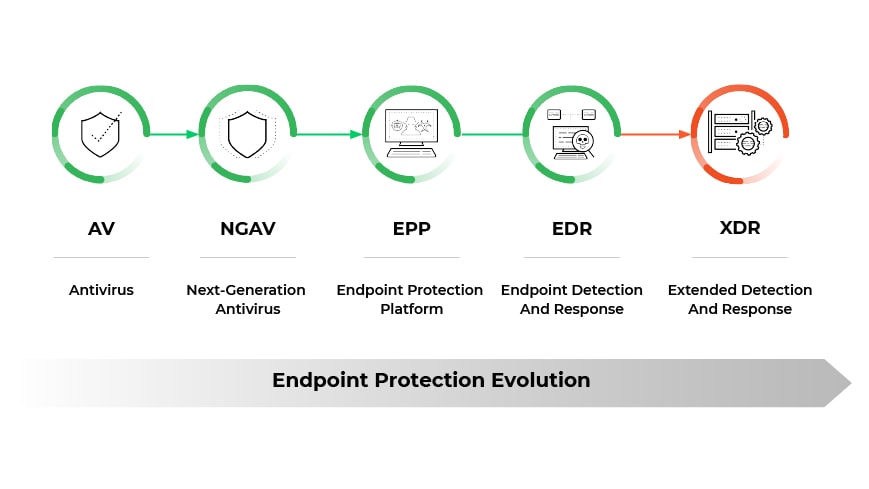
Endpoint Security
Endpoint security protects devices like computers, smartphones, and servers from cyber threats such as malware and unauthorized access. It includes tools like antivirus software, firewalls, encryption, and Endpoint Detection and Response (EDR) systems to monitor and respond to threats. By securing these entry points, organizations prevent breaches, protect data, and ensure network safety.
Cloud Security
Cloud security protects data, applications, and services hosted in the cloud from cyber threats. It includes encryption, access controls, threat detection, and compliance management to safeguard sensitive information. With businesses increasingly relying on cloud services, robust cloud security ensures data privacy, prevents breaches, and supports secure operations across shared environments.
Mobile Security
Mobile security shields smartphones, tablets, and other portable devices from cyber threats like malware, phishing, and unauthorized access. It encompasses encryption, secure app usage, strong authentication, and remote device management. Given that mobile devices manage sensitive data, having strong security is crucial for protecting personal and business information and ensuring safe connectivity.
Critical Infrastructure Security
Critical infrastructure security protects important systems and resources like energy grids, water supplies, transportation, and communication networks from cyberattacks and physical threats. It includes detecting threats, controlling access, creating response plans, and following regulations. Critical infrastructure is essential for public safety, economic stability, and national security.
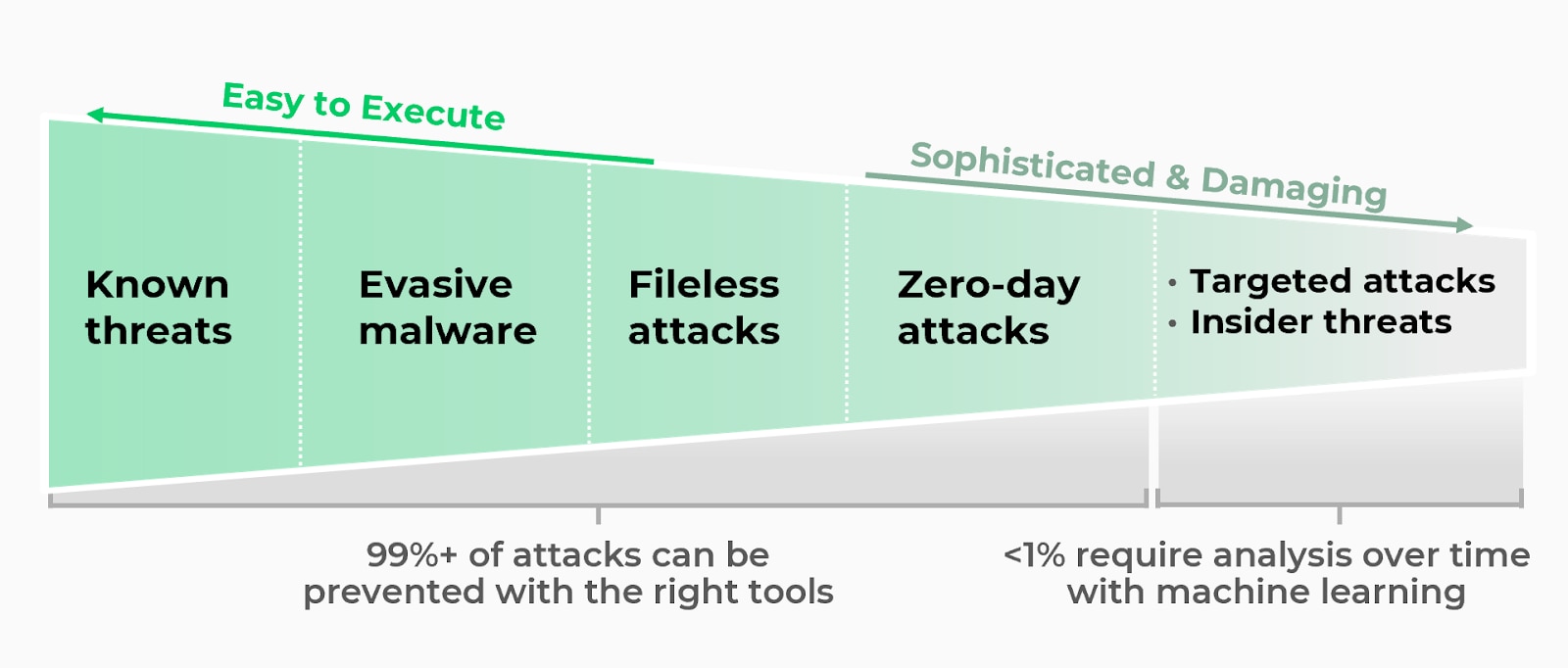
Common Cybersecurity Threats
The digital landscape warrants vigilance against various cybersecurity threats that continually evolve in sophistication and reach. Some of the most common and evasive threats are:
- AI Attacks
- Phishing and Social Engineering
- Malware
- Insider Threats
- Distributed Denial of Service (DDoS)
- Credential Theft
- Advanced Persistent Threats (APTs)
- Zero-Day Exploits
- Man-in-the-Middle Attacks
- SQL Injection
- IoT Attacks
AI Attacks
AI attacks target vulnerabilities in artificial intelligence systems to manipulate algorithms, exploit data, or disrupt operations. They include adversarial inputs, data poisoning, and model theft, requiring proactive defenses like secure training, robust monitoring, and threat mitigation strategies.
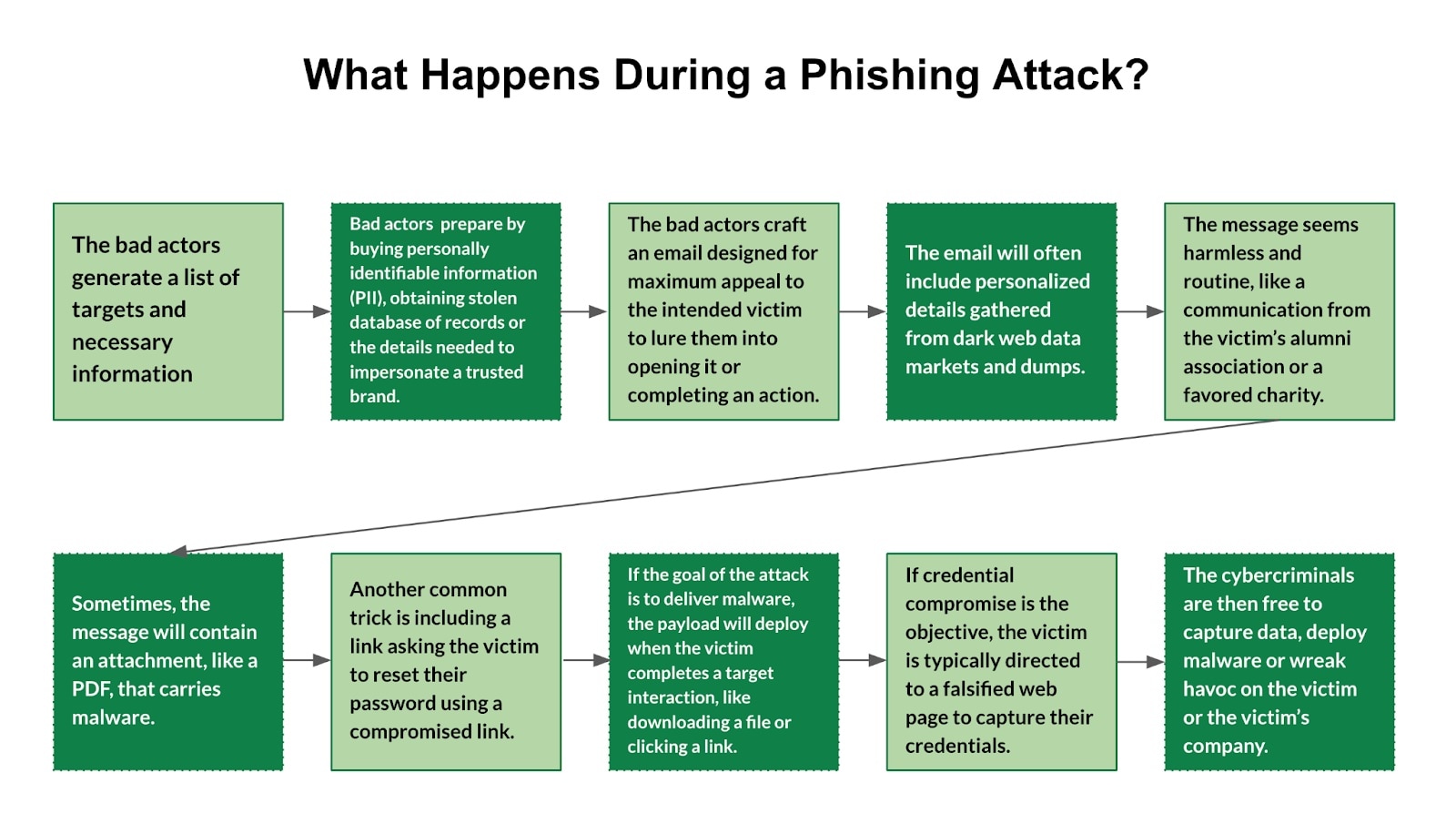
Phishing and Social Engineering
Phishing and social engineering attacks exploit human psychology to gain sensitive information, often through deceptive emails or messages that mimic legitimate sources. These tactics have become increasingly user-specific, leveraging personal details to enhance credibility.
Malware
Malware, including ransomware, is a prevalent threat where malicious software is deployed to disrupt operations, gain control of systems, or, in the case of ransomware, encrypt data to demand a ransom from the victim.
Insider Threats
Insider threats add another layer of complexity, stemming from individuals within an organization who may intentionally or unknowingly compromise security. These threats highlight the importance of robust cybersecurity measures and continuous monitoring to protect sensitive data and preserve organizational integrity against these multifaceted challenges.
Distributed Denial of Service (DDoS) Attacks
DDoS attacks involve cybercriminals overloading systems with traffic to render services unavailable, often causing financial and reputational damage.
Credential Theft
Credential-based attacks occur when attackers steal login credentials through phishing, keyloggers, or brute-force attacks to gain unauthorized system access.
Advanced Persistent Threats (APTs)
Advanced Persistent Threats (APTs) are prolonged, targeted cyberattacks where attackers infiltrate networks and remain undetected for extended periods to steal sensitive data. These sophisticated attacks often target high-value organizations, requiring advanced security measures like continuous monitoring, threat intelligence, and robust incident response to detect and mitigate.
Zero-Day Exploits
Zero-day exploits target unknown vulnerabilities in software or systems before developers release a patch. These attacks are perilous as they leave systems unprotected, requiring proactive measures like threat intelligence, vulnerability management, and real-time monitoring to minimize risk.
Man-in-the-Middle (MitM) Attacks
Man-in-the-middle (MitM) attacks occur when a cybercriminal intercepts and alters communication between two parties to steal sensitive data or inject malicious content. These attacks exploit unsecured networks and weak encryption, making strong authentication, encryption protocols, and secure connections essential for protection.
SQL Injection
SQL injection is a cyberattack where malicious code is inserted into a database query to exploit vulnerabilities and gain unauthorized access to sensitive data. These attacks can compromise databases, making input validation, parameterized queries, and regular security audits critical for prevention.
Internet of Things (IoT) Attacks
IoT attacks target vulnerabilities in Internet of Things (IoT) devices, exploiting weak security to infiltrate networks or disrupt operations. As IoT devices often lack robust protections, measures like device authentication, firmware updates, and network segmentation are essential to mitigate these threats.
Cybersecurity Best Practices
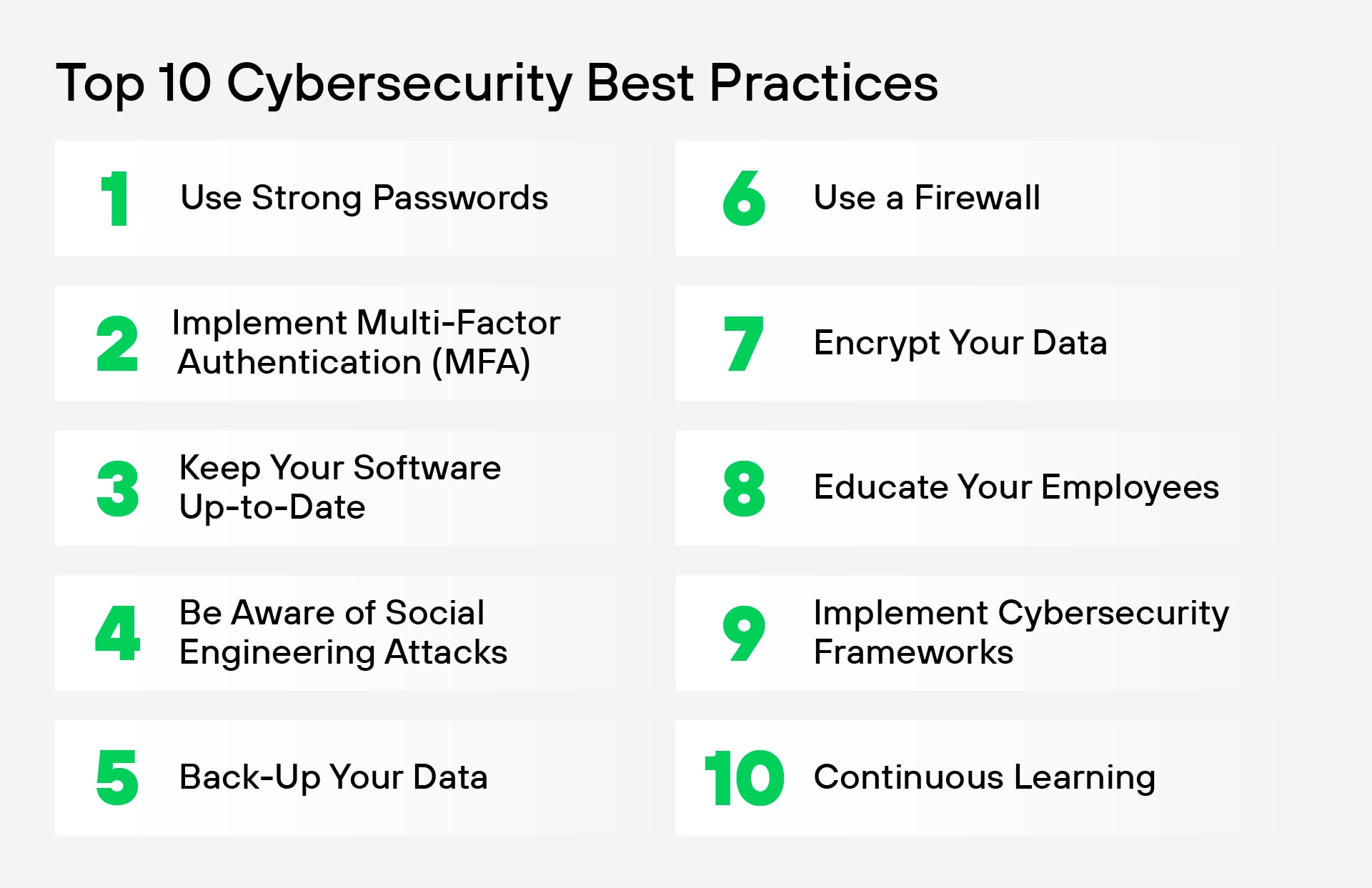
Implementing the best cybersecurity practices is essential for protecting sensitive data, ensuring operational continuity, and defending against evolving cyber threats. Below are some of the best practices:
1. Use Strong Passwords
- Create unique passwords with letters, numbers, and special characters.
- Avoid using easily guessed passwords like "password123."
- Use a password manager to store and generate secure passwords.
2. Enable Multi-Factor Authentication (MFA)
- Add an extra layer of protection by requiring additional verification methods (e.g., a one-time code or biometric scan).
- Use MFA for critical accounts like email, financial services, and administrative access.
3. Keep Software and Systems Updated
- Regularly update operating systems, software, and applications to patch vulnerabilities.
- Enable automatic updates where possible to ensure timely security fixes.
4. Implement Firewalls and Antivirus Software
- Use firewalls to monitor and control incoming and outgoing network traffic.
- Deploy antivirus and anti-malware tools to detect and remove malicious software.
5. Back Up Data Regularly
- Perform routine backups of critical data to secure locations, such as encrypted external drives or cloud services.
- Test backups periodically to ensure they can be restored effectively.
6. Educate Employees and Users
- Train employees on recognizing phishing attempts, social engineering, and other cyber threats.
- Promote awareness of security policies and safe online practices.
7. Restrict Access Based on Roles
- Use the principle of least privilege, granting users only the access they need to perform their roles.
- Regularly review and update permissions to ensure they remain appropriate.
8. Secure Wi-Fi Networks
- Use strong encryption protocols like WPA3 for wireless networks.
- Avoid using public Wi-Fi for sensitive transactions or connect through a Virtual Private Network (VPN).
9. Monitor and Audit Systems
- Continuously monitor network activity to detect anomalies or potential breaches.
- Conduct regular security audits to identify vulnerabilities and improve defenses.
10. Develop and Test an Incident Response Plan (IRP)
- Create a clear plan to address security incidents, including identifying threats, containing breaches, and recovering systems.
- Conduct regular drills to ensure preparedness among staff.
The Cybersecurity Workforce Challenge: Bridging the Global Skills Gap
The cybersecurity industry faces a critical workforce shortage as organizations worldwide accelerate digital transformation. According to the World Economic Forum, the global cybersecurity talent gap will reach 85 million workers by 2030, creating challenges and opportunities across industries.
Current Workforce Landscape
- Growing attack surface from cloud adoption, IoT proliferation, and AI integration
- Increased demand for specialized roles in AI security, cloud security, and zero trust architecture
- Rising need for professionals who understand both technical and business aspects of cybersecurity
- Emergence of new roles focused on privacy, compliance, and risk management.
In-Demand Cybersecurity Roles
- Security Operations Center (SOC) Analysts
- Cloud Security Architects
- Security Engineers
- Incident Response Specialists
- Threat Intelligence Analysts
- Application Security Engineers
- AI/ML Security Specialists
- GRC (Governance, Risk, and Compliance) Professionals
- Digital Forensics Experts
- DevSecOps Engineers
Essential Skills and Qualifications
Technical Skills:
- Cloud security platforms (AWS, Azure, GCP)
- Programming languages (Python, Java, Go)
- Security tools and frameworks
- AI/ML security principles
- Zero trust architecture
- Automation and orchestration
Non-Technical Skills:
- Risk assessment and management
- Business process understanding
- Communication and collaboration
- Problem-solving and analytical thinking
- Project management
- Regulatory compliance knowledge
Career Development and Growth
Certifications:
- CISSP (Certified Information Systems Security Professional)
- CISM (Certified Information Security Manager)
- CEH (Certified Ethical Hacker)
- Cloud security certifications (AWS, Azure, GCP)
- CompTIA Security+
- CCSP (Certified Cloud Security Professional)
Salary Trends:
- Entry-level positions: $70,000-$90,000
- Mid-level roles: $100,000-$150,000
- Senior positions: $150,000-$250,000+
- Executive roles (CISO): $200,000-$500,000+
Industry Initiatives to Address the Gap
- Public-private partnerships for cybersecurity education
- Apprenticeship and mentorship programs
- Diversity and inclusion initiatives
- Reskilling and upskilling programs
- Academic partnerships and curriculum development
- Veterans transition programs
Future Outlook
The cybersecurity job market continues to evolve with technological advancements. Professionals who combine technical expertise with business acumen, stay current with emerging threats, and adapt to new technologies will find abundant opportunities for career growth and advancement in this dynamic field.
Cybersecurity FAQs
The core functions of cybersecurity are:
- Protects Sensitive Data: Safeguards personal, financial, and business information from being accessed or stolen by unauthorized individuals or malicious actors.
- Prevents Cyber Threats: Detects, blocks, and mitigates threats such as malware, ransomware, phishing, and denial-of-service (DoS) attacks.
- Ensures Business Continuity: Keeps systems operational by preventing disruptions caused by cyberattacks, minimizing downtime and financial losses.
- Secures Digital Infrastructure: Protects critical systems like servers, databases, and cloud environments from being compromised.
- Maintains Confidentiality, Integrity, and Availability (CIA Triad)
- Confidentiality: Ensures information is accessible only to authorized parties.
- Integrity: Protects data from being altered or corrupted.
- Availability: Ensures resources are accessible when needed.
- Enables Secure Communication: Encrypts data during transmission to prevent interception and unauthorized access, especially for sensitive communications.
- Supports Regulatory Compliance: Helps organizations comply with data protection laws and regulations, such as GDPR, HIPAA, or PCI-DSS.
- Identifies and Mitigates Risks: Monitors systems for vulnerabilities and suspicious activities, enabling proactive risk management.
- Educates and Trains Users: Raises awareness about potential threats and teaches safe practices to minimize human error, which is a common cause of security breaches.
- Facilitates Incident Response: Develops and executes plans to quickly detect, contain, and recover from security incidents, limiting their impact.
Cybersecurity encompasses various domains, each addressing specific threats and vulnerabilities. Here are the seven primary types:
- Network Security
- Focuses on protecting computer networks from unauthorized access, misuse, and cyber threats.
- Key Measures: Firewalls, intrusion detection systems (IDS), virtual private networks (VPNs), and encryption.
- Information Security
- Protects data in all forms—digital and physical—from unauthorized access, modification, or destruction.
- Key Principles: Confidentiality, integrity, and availability (CIA Triad).
- Examples: Encryption, data masking, and access controls.
- Endpoint Security
- Secures devices like computers, smartphones, and tablets that connect to a network.
- Key Tools: Antivirus software, endpoint detection and response (EDR), and device management policies.
- Cloud Security
- Focuses on protecting data, applications, and infrastructure in cloud environments.
- Key Practices: Access controls, secure configuration, and encryption of data in transit and at rest.
- Example: Securing Software as a Service (SaaS) and Infrastructure as a Service (IaaS) platforms.
- Application Security
- Ensures applications are secure throughout their development and lifecycle.
- Key Practices: Secure coding, vulnerability testing, and implementing security features like authentication and authorization.
- Examples: Web application firewalls (WAF) and penetration testing.
- Operational Security (OpSec)
- Focuses on protecting processes and decisions to ensure that sensitive information isn’t leaked.
- Key Elements: Risk management, secure workflows, and awareness of sharing and storing data.
- Example: Limiting access to sensitive operational information to reduce insider threats.
- Disaster Recovery and Business Continuity Planning
- Ensures systems and operations can recover quickly after a cyber incident or disaster.
- Key Elements: Backup solutions, incident response plans, and resilience strategies.
- Examples: Offsite data storage and redundancy planning.